The Living and Dead in Good Company
Air Date: Week of October 30, 2015
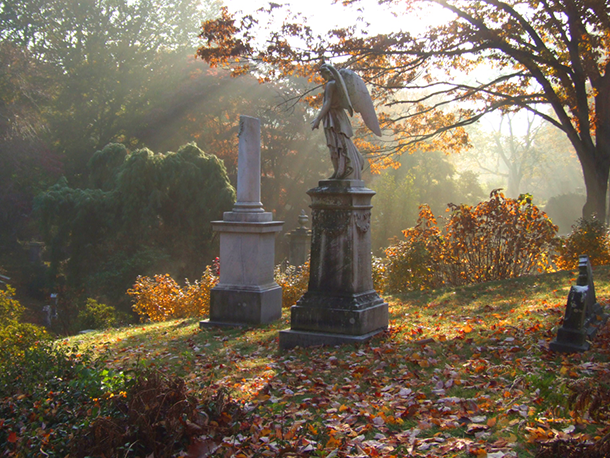
Leaves fall around headstones in Mount Auburn Cemetery. (Photo: Maureen Gilreath, Flickr CC BY-2.0)
Massachusetts’ Mount Auburn Cemetery is renowned as the final resting place for American luminaries including Henry Wadsworth Longfellow, Fannie Farmer, and Charles Sumner. But as America’s first garden cemetery, it’s also a brief home for migrating birds every spring and fall. John Harrison and Kim Nagy, co-authors of the book Dead in Good Company: A Celebration of Mount Auburn Cemetery walk through the cemetery with host Steve Curwood and observe the wildlife and visit the deceased.
Transcript
CURWOOD: You might have trouble unraveling the common thread that links cookbook author Fannie Farmer, poet Henry Wadsworth Longfellow and art collector Isabella Stewart Gardner, but all three of these nineteenth century luminaries lie peacefully – we trust - in America’s first garden cemetery. And a new book, "Dead in Good Company,”celebrates not only the stories of these famous people, but also the wildlife that Mount Auburn cemetery is now famous for. On a crisp autumn day, I headed through cemetery’s wrought-iron gates to take a walk with the book’s creators, including co-editor John Harrison.
[BIRDSONG]
HARRISON: The idea was for this to be a gardens cemetery, when it was created in 1831 by Jacob Bigelow, and you can see from the hills and valleys, the bodies of water, it is very much different than any ordinary cemetery. In fact, growing up, every now and then, someone would mention, "Have you been to Mount Auburn cemetery" and I'd say, "Gee no I haven't" and in my mind I would say“a cemetery is a cemetery." But I did finally come here and that changed my life.
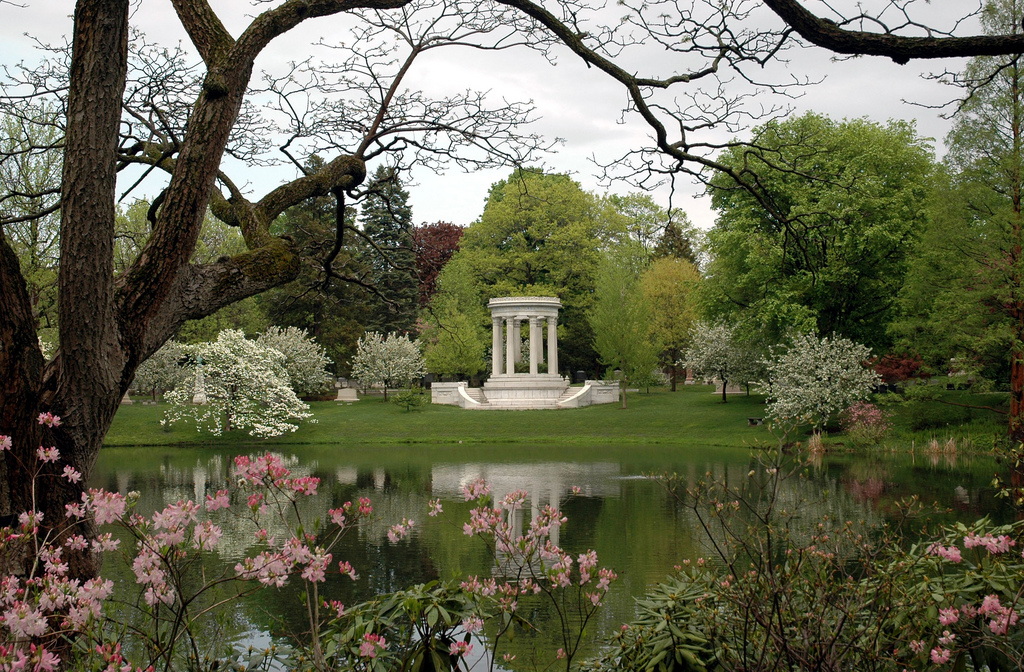
Spring arrives at Halcyon Lake, Mount Auburn Cemetery (Photo: Friends of Mount Auburn, Flickr public domain)
CURWOOD: So we're here in the cemetery and around your neck you have the strap of binoculars, which reminds me, I first really heard about this place as a birding spot.
HARRISON: Oh it is. It's a bird sanctuary and wildlife sanctuary in addition to birds, other wildlife also.
CURWOOD: So, why is it so popular with birders?
HARRISON: Well, first of all of, this is on the migration path, and if you come here in May it's like a carnival here. There are hundreds of people running around with binoculars, with cameras, looking up because these are birds you only see once a year coming up from the south. Birding is the kind of thing that once you get into, it gets under you skin.
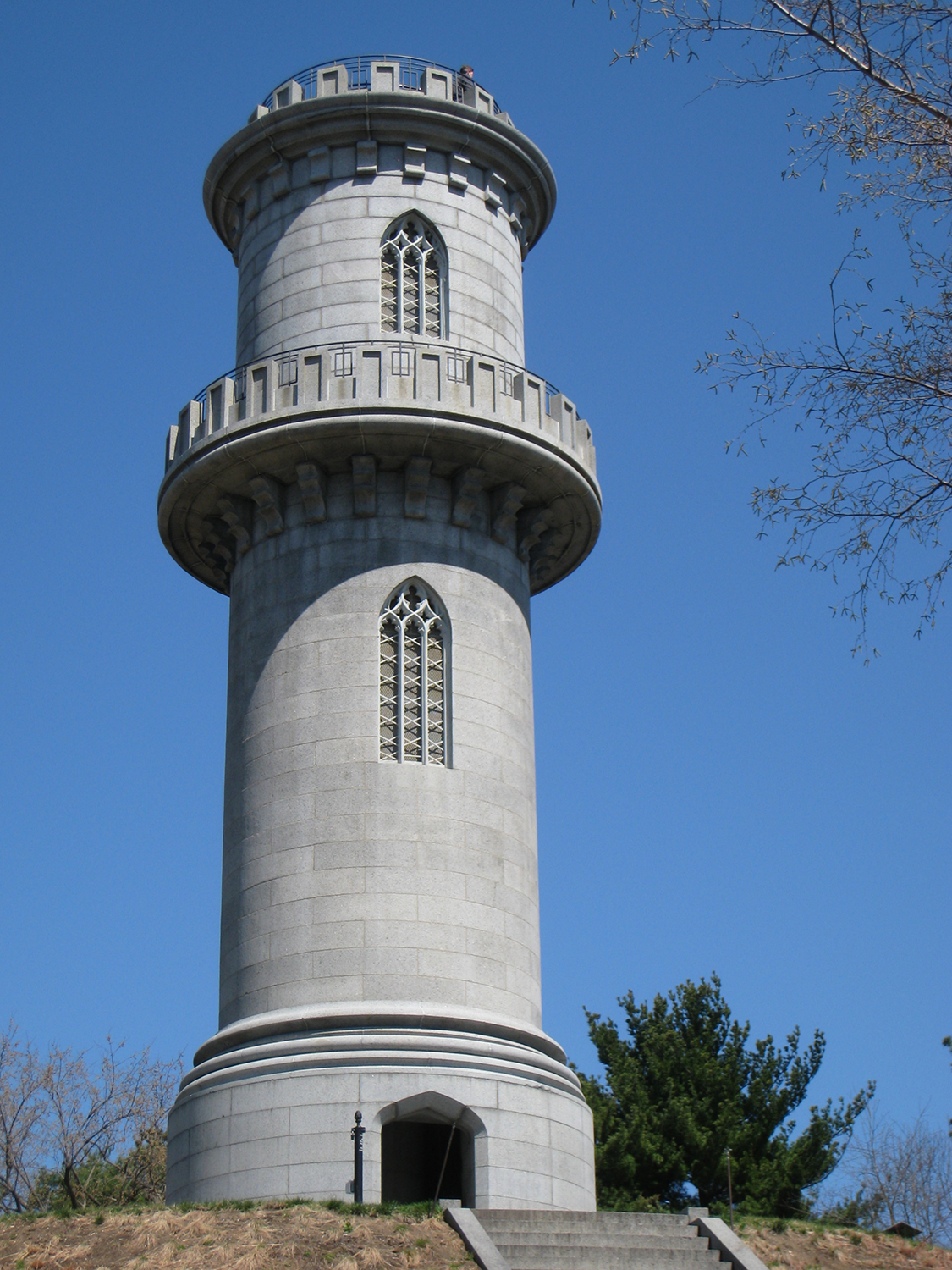
Washington Tower in Mount Auburn Cemetery located in Cambridge, Massachusetts. Architects Dr. Jacob Bigelow and Gridley J. F. Bryant constructed the building in 1852-54. (Photo: Daderot, Wikimedia Commons public domain)
CURWOOD: The birders who are listening to us are going to say,“so what do you have on your list from being at Mount Auburn cemetery?”
HARRISON: On the list, just for instance how unusual this can be, one of the very best birds that you see at the spring migration is the Cape May Warbler. It's spectacular and all of my life here I'd be lucky to see one way up in a tree for a couple of seconds. This year they just happened to land, a bunch of them, because they fly all night and when the sun comes up, the first green place they see, they all descend. And they landed and spent several days here on Cedar Avenue, which is just unbelievable. There must have been 100, 150 people. For three days you could just look over your head and see three, four, five, six Cape May Warblers coming down to within three, four feet of you. Indigo Bunting is another special bird. They were visible this year. Then the regular, well, call them the usual suspects; the Magnolia warblers, the Vireos, Black-throated Green Warblers, Black-throated Blue, Chestnut-sided Warblers, and some years are slower than others, but this year was off the charts. It was just spectacular. People were out of their minds.
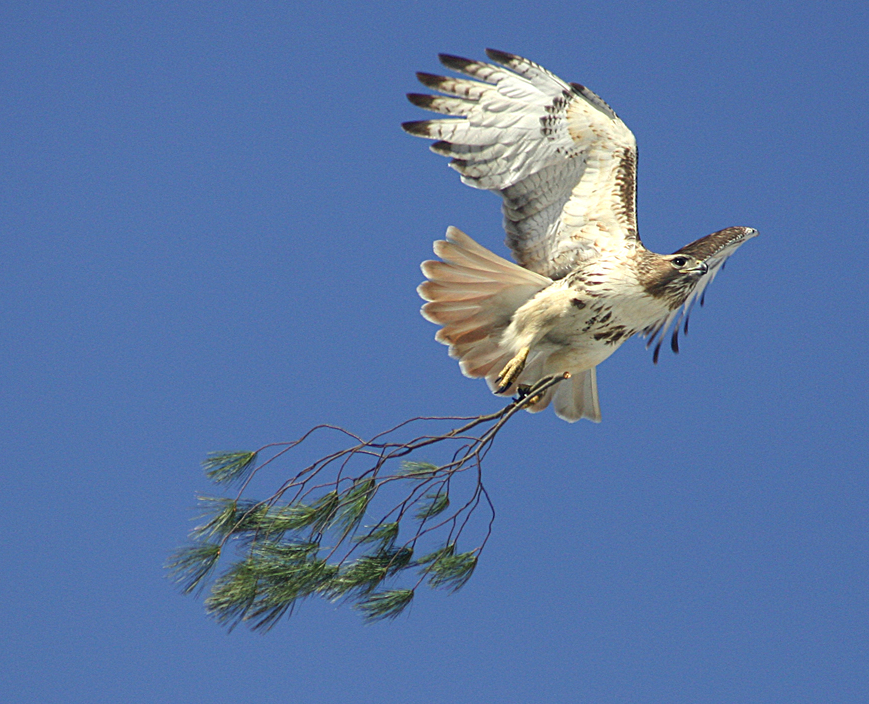
A red-tailed hawk—nicknamed “Lucy” by John Harrison—carries a spruce branch to her nest in Mount Auburn Cemetery, and her species inspired one of Harrison’s essays. (Photo: John Harrison)
CURWOOD: And what about the raptors?
HARRISON: Well we have a resident pair of Red-tailed Hawks. They're my favorite species since the beginning. This year they had two chicks. Just last week I happened to be here and the two siblings were chasing each other around. It was just beautiful. So they're always here. They're a regular part of the scene.
CURWOOD: So that's how they keep the squirrels down here, huh?
HARRISON: Yeah, that's exactly right. That's their favorite dish. Yep. I've been watching and you will see one swoop down on an unsuspecting squirrel and that's it.
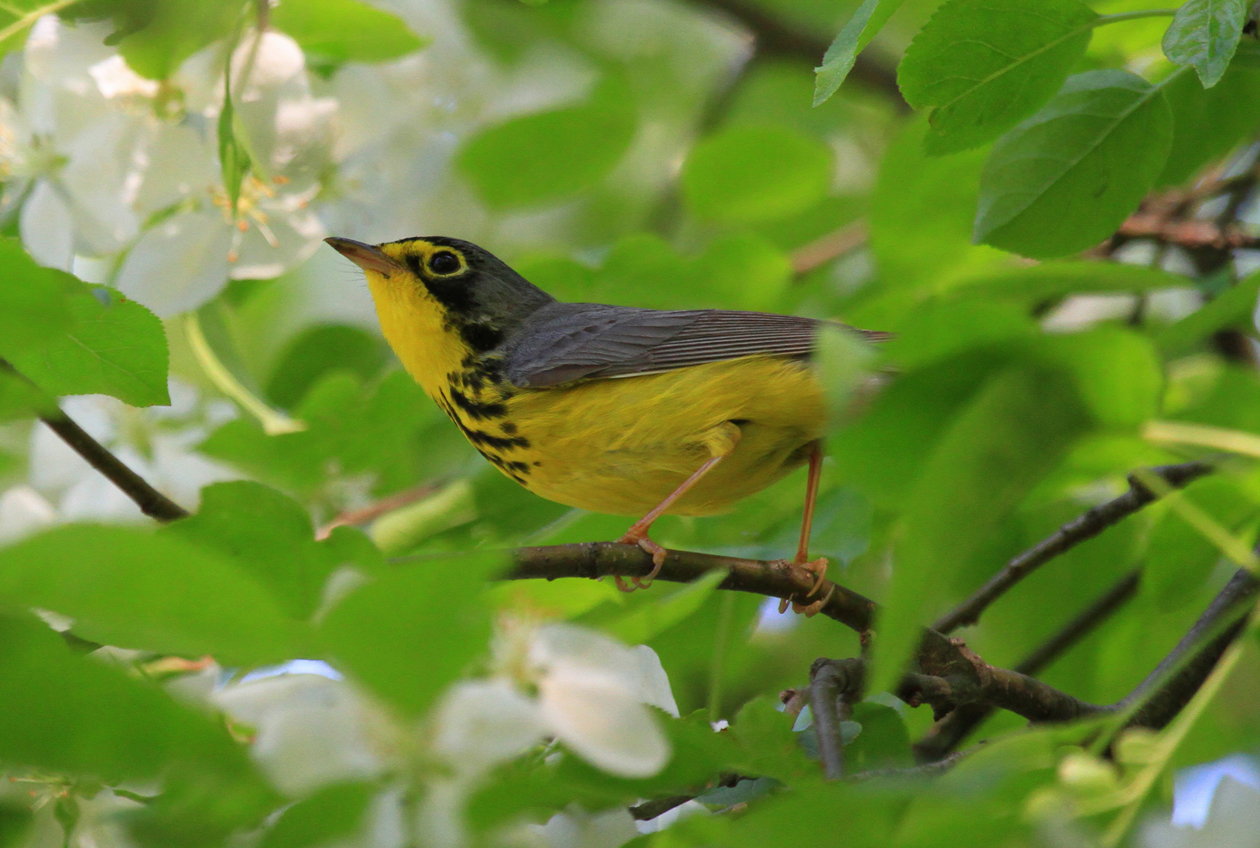
Mount Auburn Cemetery is a popular stopover spot for migrating birds, including the Canada warbler. (Photo: Kim Nagy)
CURWOOD: So how big is this place and how many people are buried here?
HARRISON: I'd say 175 acres. There's about 100,000 people buried here.
CURWOOD: And there's some pretty famous people buried here, right?
HARRISON: Yes. Yes, indeed. Quite a few famous people. Jacob Bigelow, one of the founders of the cemeteries here and Bigelow chapel is named after him. Charles Bullfinch, the architect. Buckminster Fuller, Bucky Fuller's here. Curt Gowdy, the sportscaster of the Boston Red Sox. Winslow Homer. Bernard Malamud, the author, he's at Willow Pond. And I stumbled upon his grave myself. I didn't know that until I stumbled upon it. He's one of my favorites so I was glad to find that. Arthur Schlesinger Jr.'s here. BF Skinner. Henry Cabot Lodge. Edwin Booth, John Wilkes Booth's brother, he's here. There are senators, mayors, congressmen, judges, and I can't even keep up with all them. We're mostly...Kim and I...we're here for the wildlife.
CURWOOD: And Kim, of course, is your...
HARRISON: Co-editor.
CURWOOD: Co-editor. And both of you wrote some essays for this.
HARRISON: Yes, we each wrote an essay. Mine about Red-tailed hawks, and Kim specifically about the Great Horned Owl pair that appeared her first time here. It was that year 2011 when the Great Horned Owls had two owlets and we got to see up close and personal the lifecycle of this fantastic species.
CURWOOD: So, Kim Nagy, you are the co-author of this book, "Dead in Good Company: A Celebration of Mount Auburn Cemetery,”and you wrote about owls. Why?

The cemetery’s Washington Tower provides a 360-degree view of Boston and its surroundings. (Photo: Bill Damon, Flickr CC BY 2.0)
NAGY: Well, I likened the experience of the owls with an experience I was having with my mother who had moved here and had dementia and it was a tough time. What I found most interesting was that in watching the owlets grow, they were learning how to build a roadmap for their new life, and I was learning how to build a new roadmap for my current situation.
CURWOOD: So here you are in a cemetery building new life.
NAGY: Well, as Mount Auburn cemetery was created to change people's idea of death and burial and dying in 1831, with our book we wanted to show that this is not just a cemetery but it's a place of life, regeneration, regrowth, rebirth. And so to chronicle the lives of the owlets, we knew everything about them: their parents, we named them, and their first flight and everything else, we thought it was very apt.
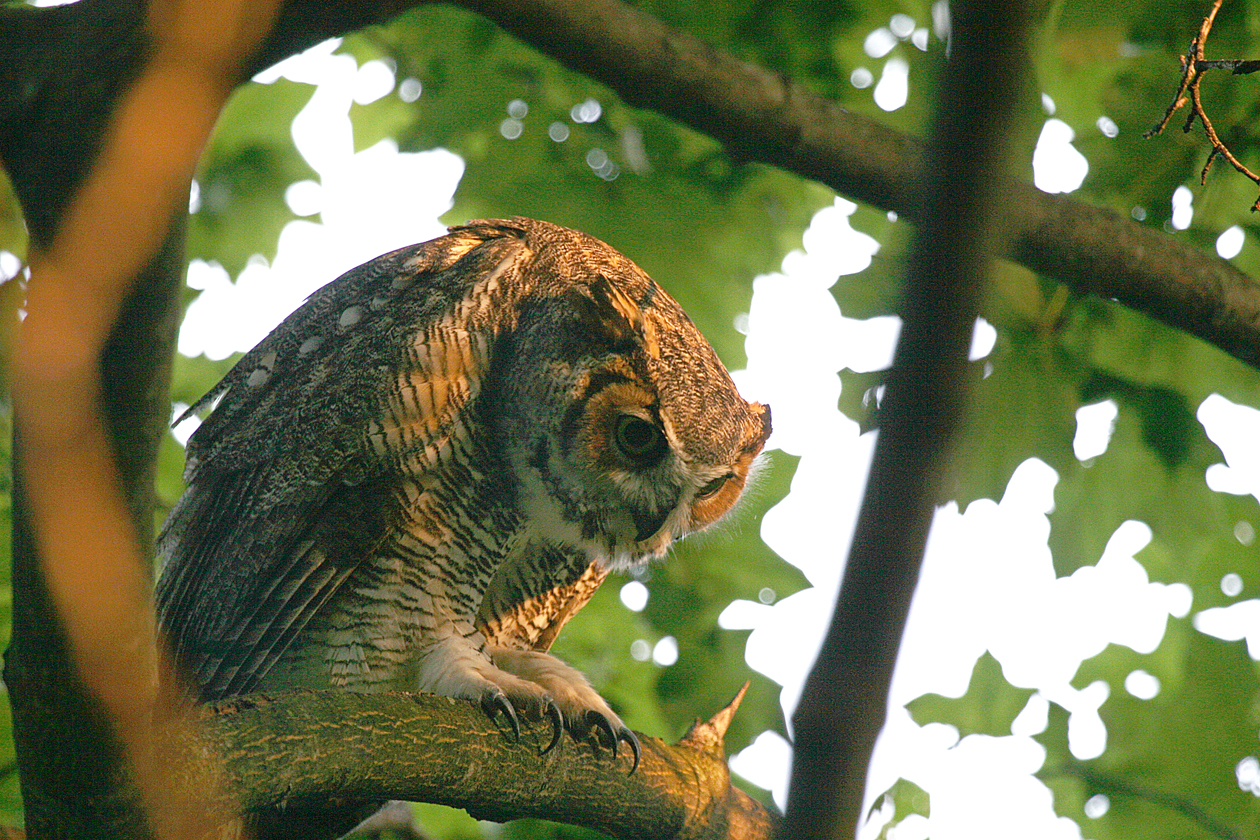
A great horned owl. (Photo: Kim Nagy)
CURWOOD: So, hey, John so what do you mean by your book titled, "Dead in Good Company." Whose company is that?
HARRISON: Oh, all the souls that are buried here. All the spirits that are buried here. In fact, in preparing the book, Kim and I felt along the way because of all the challenges that we were able to meet and overcome that there's a spirit of Mount Auburn - that's what we called it.
CURWOOD: Can I ask you, is this place haunted?
HARRISON: If it's haunted, it's haunted in a good way. It's haunted by helpful spirits.
CURWOOD: Have you been here at night?
HARRISON: I was here one night after 11. Joe Martinez, one of our essayists who wrote about the spotted salamanders in the dell and the vernal pool, I was invited to come watch that develop. The night I was here you could shine a flashlight in the vernal pool and she these beautiful spotted yellow salamanders, and it is very different at night. It's a whole different experience.
CURWOOD: Spooky?
HARRISON: Not spooky. Just serene, but different, because it's dark. But it was beautiful.
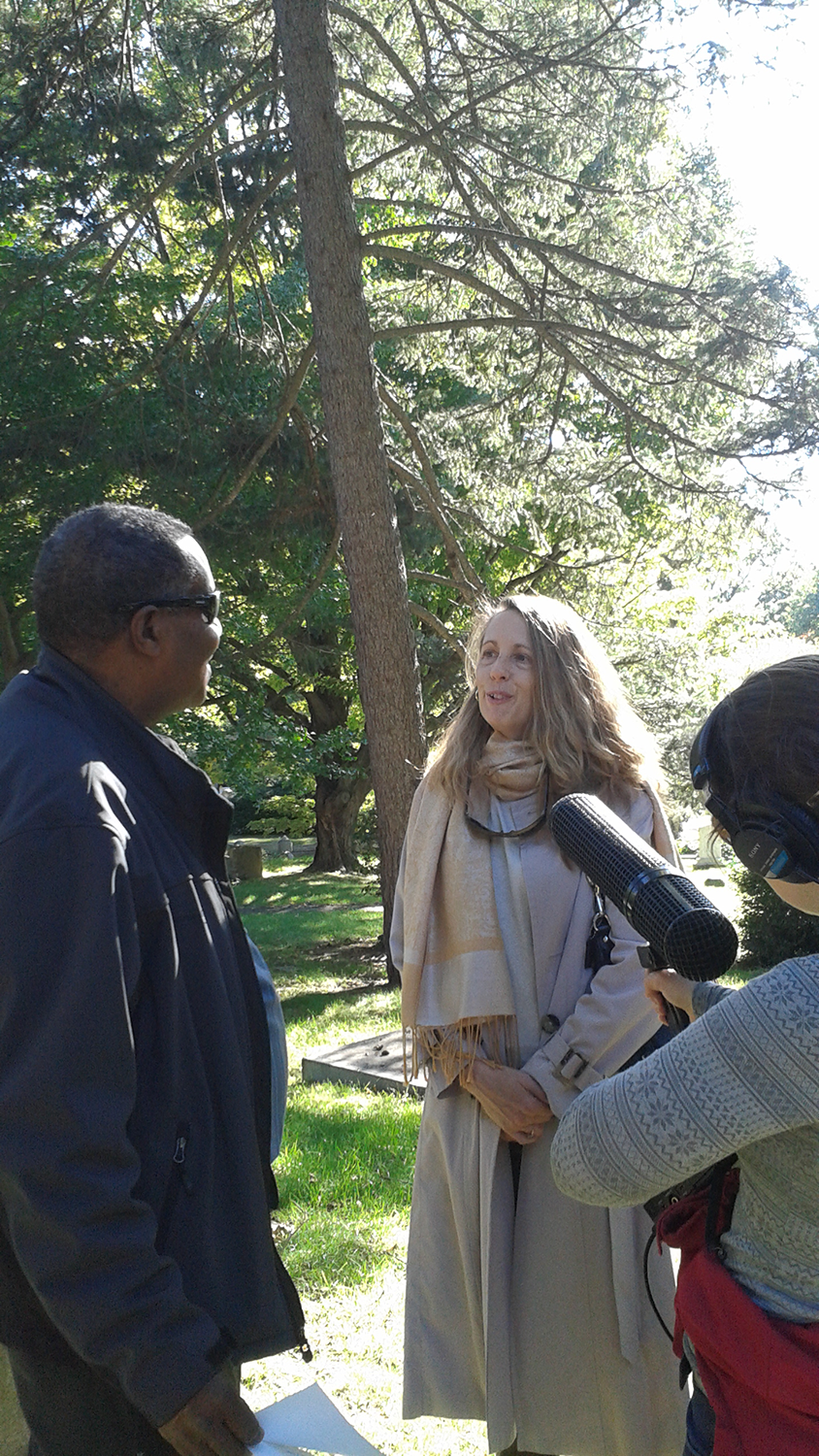
Kim Nagy tells Steve Curwood about her favorite place in Mount Auburn Cemetery, the Consecration Dell where she watched owlets grow up. (Photo: Helen Palmer)
CURWOOD: What about the owls? [HOOTS]
HARRISON: Well, occasionally we would hear them at dusk. The security guards are here all night, are here through out the night, they often hear them and see them flying around. So there's more activity because they're nocturnal.
CURWOOD: So Charles Sumner, the famous Massachusetts senator, during the approach to the Civil War, is buried here, and let's walk over to his gravesite.
HARRISON: Sure.
[WALKING AND FOOTSTEPS]
HARRISON: There's a Red-tailed hawk, our guardian, flying over. It must be really great to be a Red-tailed hawk on a day like this.
CURWOOD: Indeed. So who knew 175 acres of beautiful gardens would become this key wildlife sanctuary for greater Boston?
HARRISON: Yeah, really, really in the center of the city. It's really amazing, but it's because of all the attention to detail. And all of trees, I mean, there are certain bird species like certain trees and certain berry trees and crabapple trees and there's something for all of them so when they do land here they stay for a while until they have enough energy to move on.
CURWOOD: So where are we now?
HARRISON: We're at the grave of Charles Sumner and William Martin whose essay, "The Actor and the Hawk", is the first in our book, is going to tell us a little about Charles Sumner.
CURWOOD: OK, Bill, what's the story you have for us?
MARTIN: Well, of course, you know that Sumner was one of the leading abolitionist voice in United States Senate in the run up to the Civil War, got himself caned on the floor of the United States Senate as a result of the speech that he gave calling out the senator from South Carolina and some people think that led to the war itself. He came home, he recovered, and after Lincoln was elected, Sumner became, you could say, the sharpest abolitionist thorn in Lincoln's side. On July 4, 1862, Sumner went to the White House to talk to Lincoln. He said to Lincoln that day,“Mr. President, on Independence Day it is time to give the American people a great gift, the gift of emancipation.”The war was not going well, Sumner understood that a new moral imperative had to be added if the north was to win the war, and Lincoln said to Sumner that day, "Senator, if I free the slaves, three more states will go out of the union, and half my officers will resign.”He was trying to walk a very fine line between men like Sumner who was speaking powerful moral truths to him and people on the other side of the political aisle in the north who were just trying to hold the union together "and we'll take care of that that slave issue later on." Lincoln told Sumner that day“emancipation is a thunderbolt that will keep.”He didn't tell Sumner however that he was already writing the Emancipation Proclamation, but the story gives you an idea of the moral voice that Sumner was and the fact that while Lincoln was a politician and couldn't say out right, "I hear you. I hear you," he heard him.
CURWOOD: How has the Mount Auburn cemetery inspired you and your work? You've written, what, ten books now?
MARTIN: A place like this for me because I write historical fiction, is probably more alive than it is to most people because the stories, like the one that I just told you about Charles Sumner, end up being dramatized in my novels, and so it's always a thrill to come where those people have their last resting place.
CURWOOD: Bill, you have an essay along these lines, it's in this book. Could you please read from your essay that opens this book?
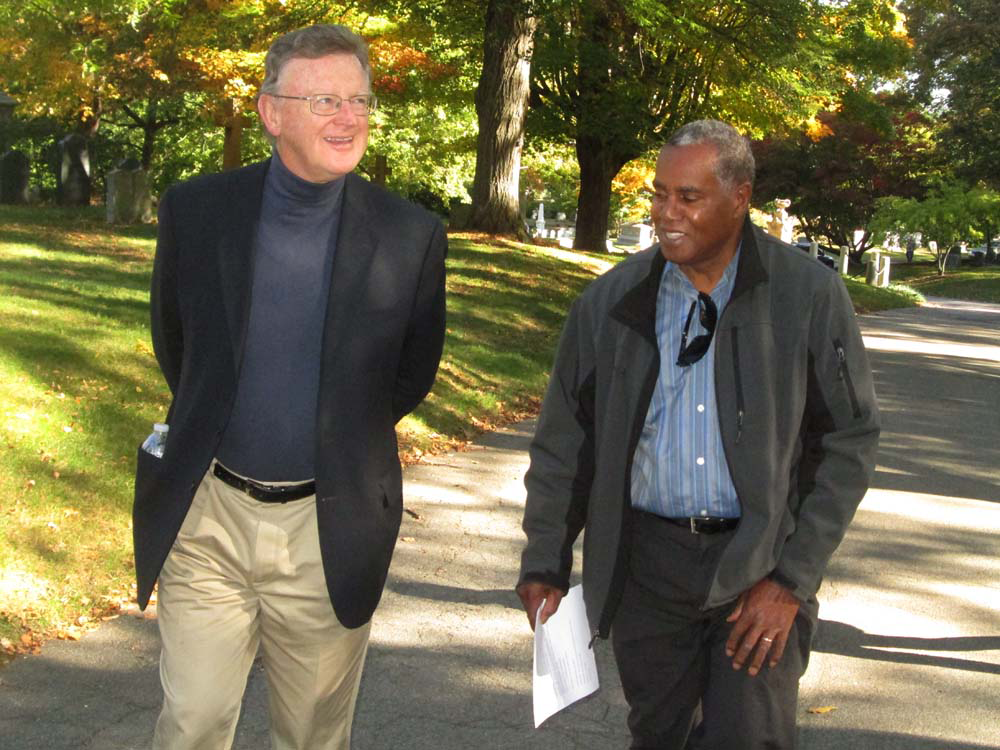
Essayist Bill Martin walks with Steve Curwood to the grave of Charles Sumner. (Photo: John Harrison)
MARTIN: Sure.“Stories are everywhere in Mount Auburn cemetery. Beneath every marker and atop every monument, everyone who lies here lived as a character in his own drama. Some performed grand deeds others only dreamed them, but the moments they lived were as vivid, as colorful, as hot or cold as joyous or terrifying as any that we live now.”
CURWOOD: So, what's your favorite spot in the cemetery. John?
MARTIN: Let's see; my favorite spot is Weeping Beech at the RH White mausoleum, not too far from here because that's where I studied my first Red-tailed hawk, Lucy, which I wrote about my essay. It's always number one on my checklist when I'm here.
CURWOOD: And Kim Nagy, what's your favorite spot in Mount Auburn cemetery?
MARTIN: My favorite place in the cemetery is where the owls were in the dell. I think it's a great mysterious place. It's very beautiful and that's where the owls flew around right above the vernal pool.
CURWOOD: Bill, your favorite spot in Mount Auburn cemetery?
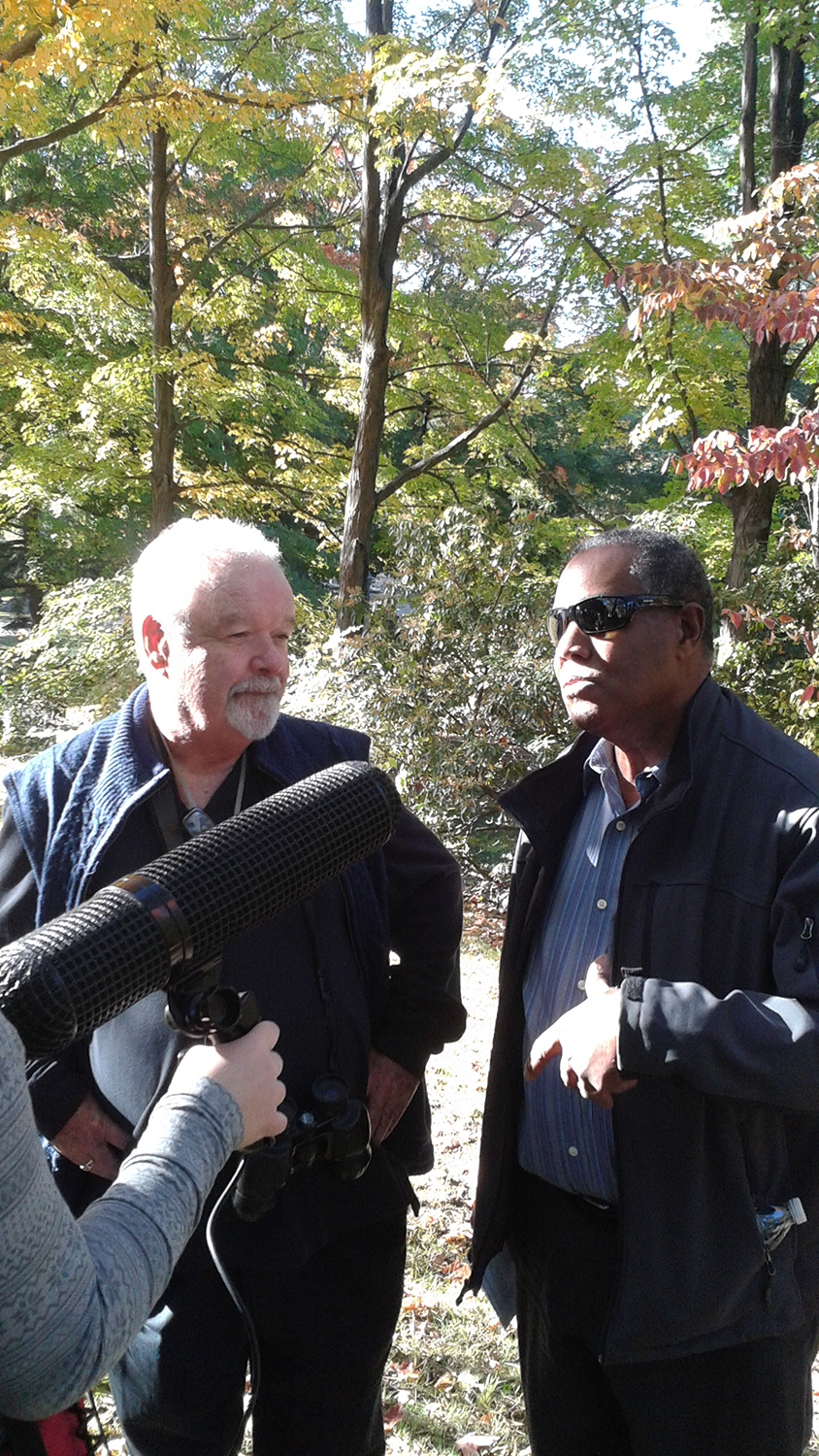
John Harrison talks with Steve Curwood at Mount Auburn Cemetery. (Photo: Helen Palmer)
MARTIN: My favorite spot in Mount Auburn cemetery is the top of the Washington tower from which you can get yourself a 360° view the hills of Massachusetts and Boston and the Charles River and Cambridge and all of the places that in so many ways form the landscape of my imagination, and one day we were here, my wife and I with John, on the top of the Washington tower and we were surrounded by young hawks all of them testing their wings, [HAWKS CALLING] and they were riding the updrafts all around us up there on the top of the tower, sweeping, screeching. And as I saw them doing this, I have to say I was thinking about the whole cycle of nature and something in Keats’ old Nightingale, and the quote that jumped to mind was,“Thou was not born for death immortal bird, No hungry generations tread thee down. [SOUND OF NIGHTINGALE SINGING] The voice I hear this passing night was heard in ancient days by emperor and clown.”The whole idea, of course, that we're down here on the ground amidst these magnificent monuments and yet nature's cycle continues and continues in the great circle of those hawks swooping around that tower.
CURWOOD: Bill Martin is the New York Times best-selling author of 10 novels and an award-winning PBS documentary and more. John Harrison is a book distributor and an avid photographer. He and Kim Nagy are co-editors of "Dead in Good Company: A Celebration of Mount Auburn Cemetery". John, Bill and Kim, thank you so much for taking the time today.
MARTIN: Thank you, it's been a pleasure.
HARRISON: And likewise, we appreciate that you allowed us to do this.
NAGY: Thanks so much, Steve.
Links
The world’s first garden cemetery, Pere Lachaise
“Landscape Architecture and the ‘Rural’ Cemetery Movement”
Dead in Good Company: A Celebration of Mount Auburn Cemetery
Mount Auburn Cemetery is a Mass Audubon Important Bird Area
Living on Earth wants to hear from you!
Living on Earth
62 Calef Highway, Suite 212
Lee, NH 03861
Telephone: 617-287-4121
E-mail: comments@loe.org
Newsletter [Click here]
Donate to Living on Earth!
Living on Earth is an independent media program and relies entirely on contributions from listeners and institutions supporting public service. Please donate now to preserve an independent environmental voice.
NewsletterLiving on Earth offers a weekly delivery of the show's rundown to your mailbox. Sign up for our newsletter today!
 Sailors For The Sea: Be the change you want to sea.
Sailors For The Sea: Be the change you want to sea.
 The Grantham Foundation for the Protection of the Environment: Committed to protecting and improving the health of the global environment.
The Grantham Foundation for the Protection of the Environment: Committed to protecting and improving the health of the global environment.
 Contribute to Living on Earth and receive, as our gift to you, an archival print of one of Mark Seth Lender's extraordinary wildlife photographs. Follow the link to see Mark's current collection of photographs.
Contribute to Living on Earth and receive, as our gift to you, an archival print of one of Mark Seth Lender's extraordinary wildlife photographs. Follow the link to see Mark's current collection of photographs.
 Buy a signed copy of Mark Seth Lender's book Smeagull the Seagull & support Living on Earth
Buy a signed copy of Mark Seth Lender's book Smeagull the Seagull & support Living on Earth

